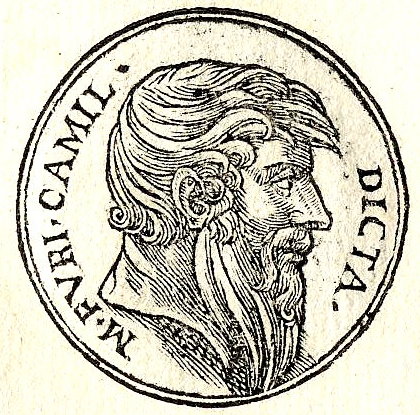Reforms of Camillus
Marcus Furius Camillus (Latin: Marcus Furius Camillus; c. 447 – 365 BC) was a Roman statesman and military leader. According to Livy, he held a number of high-ranking state positions: he served as censor in 403 BC, was military tribune with consular power six times (401, 398, 394, 386, 384, and 381 BC), was appointed dictator five times (396, 390, 389, 368, and 367 BC), was awarded four triumphs, and served as interrex three times. For driving out the Gauls, he was given the title "Second Founder of Rome." As a patrician, he consistently sided with the patricians in their struggle against the plebeians.
Camillus’s father was Lucius Furius Medullinus, a military tribune. In 396 BC, Camillus captured the Etruscan city of Veii, which had been under siege for ten years. After this victory, he was accused of unfair distribution of the spoils. Believing the accusations unjust, Camillus went into voluntary exile in the city of Ardea. In 387 BC, while still in exile, Rome was captured by the Gauls under the leadership of their chieftain Brennus. It is believed that at this time, the Roman Republic was on the brink of collapse. Camillus was invited to return from exile and lead the fight against the Gauls. Camillus was appointed dictator. He gathered troops from allied cities and the remnants of the Roman army at Veii and expelled the Gauls from Rome. Shortly thereafter, the Roman army under Camillus's command decisively defeated the Gallic forces.
After the defeat of the Gauls, some of the plebeians decided to relocate from the devastated Rome to Veii. Camillus persuaded them not to do so but rather to take an active part in the reconstruction of the ruined Rome. Although he sided with the patricians in their ongoing struggle with the plebeians, Camillus convinced them to make certain concessions to the plebeians.
Subsequently, the Roman army under Camillus's command waged successful wars against the Aequi, Volsci, and Latins. When the Gauls invaded Rome again, Camillus was once more appointed dictator in 367 BC. Under his leadership, the Romans defeated the Gauls in the Battle of Alba. Two years later, Camillus died of the plague during an epidemic.
 Marcus Furius Camillus
Marcus Furius Camillus
The campaigns of Camillus clearly demonstrated the value of his military reforms.
One of the most notable components of the military organization introduced by Servius Tullius was the distinction between the hoplite armament of first-class soldiers and the heavily armed soldiers of the second and third classes, who, instead of the round hoplite shield (hoplon), carried the elongated scutum. It is believed that this shield was first adopted into the Roman army by Romulus, who borrowed this design from the Sabines, replacing the earlier used "Argive shields." Later, Servius Tullius, when introducing the phalanx in Rome, replaced the scutum with the hoplite shield used by the Etruscans. However, some soldiers, as we have seen, continued to be armed with the scutum during this period. Finally, as Livy testifies, the Romans abandoned the use of round shields and returned to the use of elongated ones. This change coincided with the transition from the hoplite phalanx to the manipular formation:
"In earlier times, Roman shields were round, but from the time when soldiers began receiving pay, they replaced them with larger, elongated ones, and from the phalanxes that resembled the Macedonian ones, there later emerged a battle order made up of maniples."
Livy’s mention of "from the time when soldiers began receiving pay" allows us to date this event to after the fall of Veii in 396 BC. Therefore, some historians refer to this as the so-called "military reform of Camillus." These innovations are briefly mentioned by Plutarch concerning the events of 367 BC, when Camillus, once again appointed dictator, defeated the Gauls in the Battle of Alba:
"He knew that the main strength of the Gauls lay in their swords, which they used crudely, without skill, mostly cutting at arms and heads. The dictator ordered almost all the soldiers to wear helmets made entirely of iron, with smooth surfaces, so that the swords would either slide off them or break. He also ordered the rim of the shield (thyreos) to be reinforced with a bronze plate—wood alone could not withstand the blow, and he taught the soldiers to use javelins (hyssos) as long spears, placing them under the blows of the enemy's swords."
As this account indicates, Camillus did not arm his soldiers with new weapons but improved the existing ones. The large shield—thyreos is the term used by Plutarch—he ordered to be reinforced with a bronze edging. The heavy javelin, or pilum—Plutarch uses its Greek name hyssos—Camillus suggested not to throw at the enemy upon closing in, but to place under the blows of their swords, causing the blades to become ineffective. This innovation proved effective: the Romans defeated the Gauls.
If Plutarch's account is based on real events, it would be a good testimony to the "rearmament" of the Roman army that occurred between 396 and 367 BC. However, the story of the dulled Gallic swords is likely no older than the one told by Polybius in the mid-2nd century BC. The mention of the bronze edging on the shield may also trace back to Polybius's description of the Roman shield.


